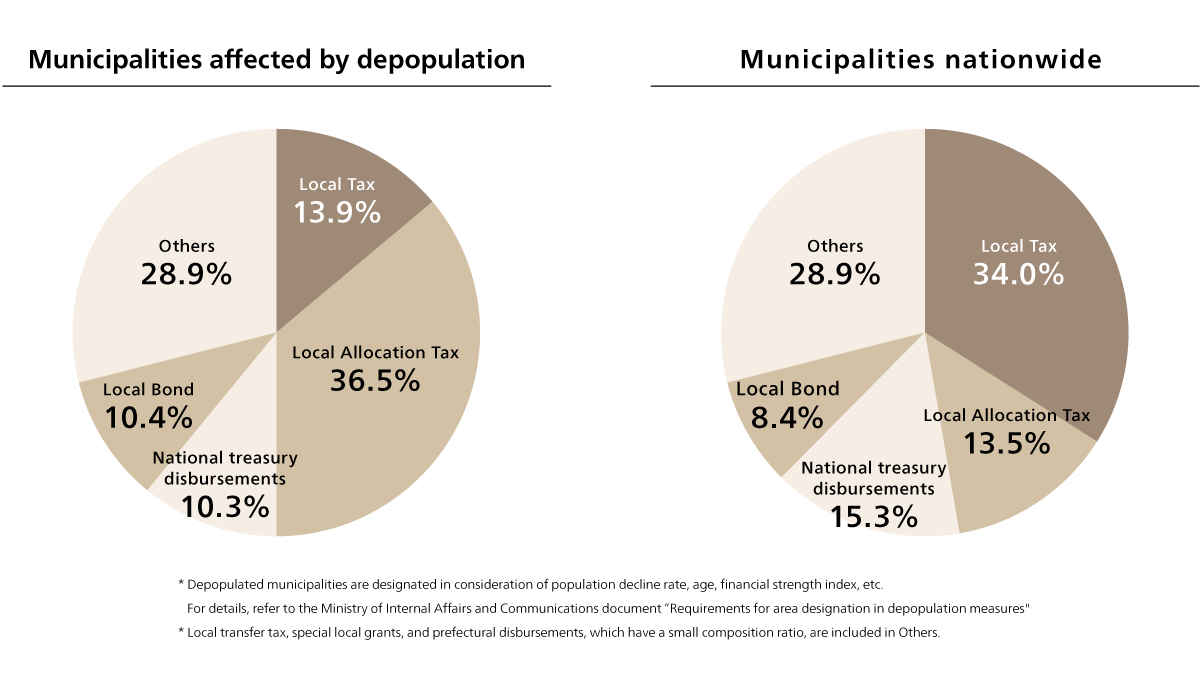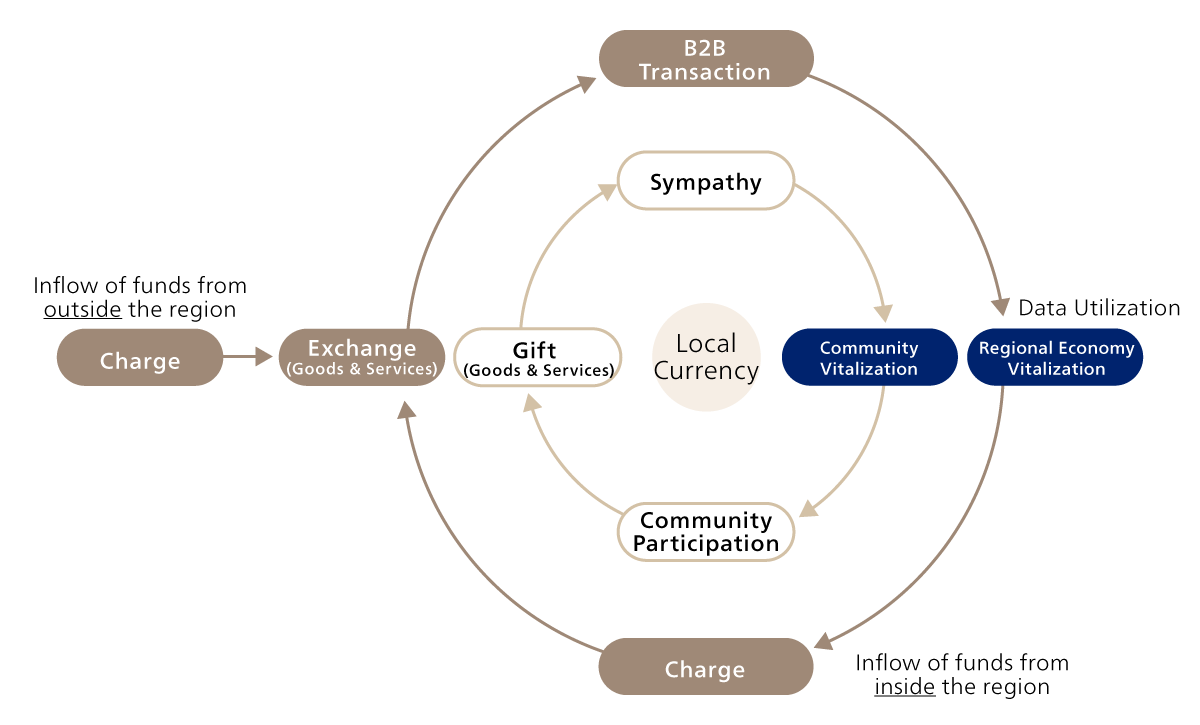Digital Local Currency*
-Significance From the Perspective of Local Governments and Regional Financial Institutions-
January 5, 2023
(*) Note: Synonyms include "Community Currency," which is used in the context of unions which may be characterized as an entity with exclusivity like membership and “Regional currency”, which is used for a wider area with less degree of exclusivity. In this Insight, vocabulary is unified as “Local Currency”
Local Currency has been attracting a lot of attention in recent years, especially among local governments and local financial institutions. On the other hand, many people may feel that the Local Currency has been on the wane since the boom in their issuance of the early 2000s. Why, then, is there renewed interest in Local Currency again? The key word is “digital”. In the power of digital technology, Local Currency has renewed its interest again.
Nevertheless, there are major issues that need to be addressed such as (a) the degree of involvement by local governments and local financial institutions in providing Local Currency and (b) how they can monetize from business point of view. In fact, long unanswered question whether to regard Local Currency as “a business” or “a public utility” requires further cases and considerations. Therefore, in this Insight Series on “Digital Local Currency”, this first edition will provide a fundamental perspective including the macro environment surrounding Local Currency, definition and significance of Local Currency, Types of Local Currency, and points to consider in business, while also look upon the issues mentioned above: (a) the degree of involvement by local governments and local financial institutions in providing Local Currency and (b) how they can monetize from business point of view.
1. Macro Environment Surrounding Local Currency
One of the reasons why the issuance of Local Currency is being considered is the depopulation of the region and its fragile economy. Local Currency is considered as one of method to resolve these social issues. Japan’s population peaked at about 128million in 2010 and is estimated to decline to about 93 million by 2060*1, and this trend is more pronounced in the rural areas. As seen in Figure 1, the ratio of local tax revenue to the revenue of depopulated municipalities is 13.9%, which is significantly lower than the national figure of 34.0%. This indicates that depopulated areas are insufficient in independent financial resources, and their fiscal structure is fragile and dependent on the central government*2. Not only is there a decrease in manpower and the fragility and dependence of the economy, but there are also social concerns such as the weakening of social bonds and even the disappearance of the community itself.
Figure 1: Ratio of Local Tax Revenues in Revenue Component

-
Reference: Created by ABeam Consulting based on the 2020 census by the Ministry of Internal Affairs and Communications.
While social issues are becoming more prominent in the context of depopulation, Local Currency is being considered to help solve these issues. In particular, the recent focus on Local Currency is largely due to the fostering of an environment related to initiate and apply digital economy for bringing more efficient and secure social environment. Within this context, various initiatives have been started to consider including the promotion of cashless payment, the spread of Local Currency platforms, and the growth of blockchain technology.
2. What is a Local Currency?
The unanswered question as to what the exact definition of Local Currency is remains to be discussed, yet to-date, the 4 major characteristics have been observed per below:
(1) Not to be legal tender
(2) To be circulated only in specific area
(3) To possess the basic functions of currency as a (a) medium of exchange, (b) a measure of value, and (c) store of value
(4) To have social value
Supplement to (3) To possess the basic functions of currency as a (a) medium of exchange, (b) a measure of value, and (c) store of value, for (a) medium of exchange, Local Currency can be exchanged for goods and other items within that specific area and have the role of preventing the outflow of funds outside the region and consequently promoting economic circulation within the region. For (b) a measure of value, Local Currency use their own currency unit and have measure of value. In many cases, the currency unit is equivalent to the Japanese Yen. For (c) store of value, Local Currency is intended for local use only and their position as store of value is limited. Due to the reason, many Local Currencies have an expiration date or depreciate over time and thus, the function of gaining interest (i.e., value of capital increase) is also purposely eliminated.
Regarding (4) To have social value, Local Currency has various ways to measure both economic value and social value. For this discussion, economic value is characterized as something directly and numerically measurable, whereas social value is more of indirectly and less numerically measurable. Moreover, social value has value beyond economic rationality. By purposely limiting the scope and purpose of use, Local Currency would give meaning of use in the area. For example, Local Currency can also be received in situations other than labor or sales such as participation in local volunteer activities or giving gifts within the community. Other example would be purchasing local specialties where people do not judge the consumption not only by the experience of purchasing of the goods but experience beyond purchasing through based on their participation in the community. Visualizing local participation in the form of currency would also encourage its expansion. Thus, Local Currency have both economic and social aspects.
In promoting local expansion using monetary medium, Local gift certificate has been often considered, and now gradually may be considered as a supplement to Local Currency. Local gift certificate, which has been used and still widely issued as an economic measure to promote consumer demand and consumption for the purpose of promoting regional development, has same features of Local Currency mentioned in the 4 major characteristics above except (3) (a) medium of exchange is limited. In addition, Local Currency can be charged repeatedly to be used in multiple payment occasion. However, local gift certificate is basically intended for one-time purchase and cannot be used repeatedly. In other words, the recipient cannot become a re-user of the coupon as it is, and must assume a situation where, for example, the coupon must be returned to the program management office each time to encash the coupon to receive in form of either cash or account remittance of the coupon receiver. Despite the fact whether chargeable or non-chargeable, in practice, there are steps where premium digital gift certificate is issued to first increase the number of users, and then a similar business scheme is inherited to lead to a digital Local Currency as in many cases.
3. Significance of Local Currency
Local Currency have two aspects: economic and social. Why, is the issuance of a Local Currency being considered? The significance of a Local Currency can also be considered from aspects described per below.
First, the economic aspect is to prevent the outflow of local resources from the region in aim to stimulate the economic activities as much as possible in the region. For example, even if the government subsidizes the region and tourists consume within the region, if the funds are diverted to consumption outside the region such as through e-commerce sites, the region’s economy will not circulate. Similarly, data leakage is another example. If local consumption is done by credit card or QR payment, the data cannot be utilized by the local stakeholders themselves due to the industrial credit card scheme, even though it is the data of the region. In this regard, a Local Currency could prevent economic and data leakage. In addition, new positive uses can be considered such as an approach to promote tourism consumption.
Second, the social aspects include contributions to stimulate (a) regional participation and communication revitalization, as well as (b) contributions to the formation of a recycling-oriented society that utilizes the region’s natural resources. Examples of (a) regional participation and communication revitalization, include cases where Local Currency is earned by performing volunteer work or participating in community events. In addition, some Local Currencies seek to further acquire social credibility by making the history of receipt of Local Currency and account status visible on the app and sharing it with all participants. An example of (b) contributions to the formation of a recycling-oriented society that utilizes the region’s natural resources, would be the “tree stations” that have been introduced in mountainous areas which forests residues and thinned wood are used as resources for wood boilers and other equipment. This aim is to create a form of circulation for both nature and the economy by applying the regional gift certificate called Mori Ken (“forest ticket” in Japanese) serving as lubricating oil*3. Forest owners and other registered shippers can receive Mori Ken by bringing thinned lumber and other materials to the program management office. Then thinned wood is traded as fuel for boilers at local hospitals and hot water pools. Registered shippers, on the other hand, can use the Mori Ken they received at local gas station, restaurants, and other locations. Merchants who receive the Mori Ken can either cash them in through the program management office or reuse them at other merchants.
Figure 2 visualizes these two aspects. The outer circle represents the economic aspect, and the inner circle represents the social aspect, both of which are in the form of the economy and society rotating and circulating from place to place.
Figure 2 Significance of Local Currency

Local Currency prevent the outflow of resources outside the region, stimulate economic and social circulation within the region, and orchestrate the inflow of funds from outside the region. Through these measures, regional self-sustainability would be promoted. On the other hand, to issue Local Currency and maintain their circulation, establish as sustainable business is required. In the next part 2 of this Insight Series, various considerations including service design to establish a Local Currency as a business, will be discussed.
-
Notes
*1: “2022 White Paper on Aging Society (Summary Version),” Cabinet Office, Government of Japan
https://www8.cao.go.jp/kourei/whitepaper/w-2022/gaiyou/04pdf_indexg.html
*2: Created by ABeam Consulting based on the 2020 Census by the Ministry of Internal Affairs and Communications
https://www.stat.go.jp/data/kokusei/2020/index.html
*3: Ki no Eki Project portal site
http://kinoeki.org/modules/pico3/index.php?content_id=15


